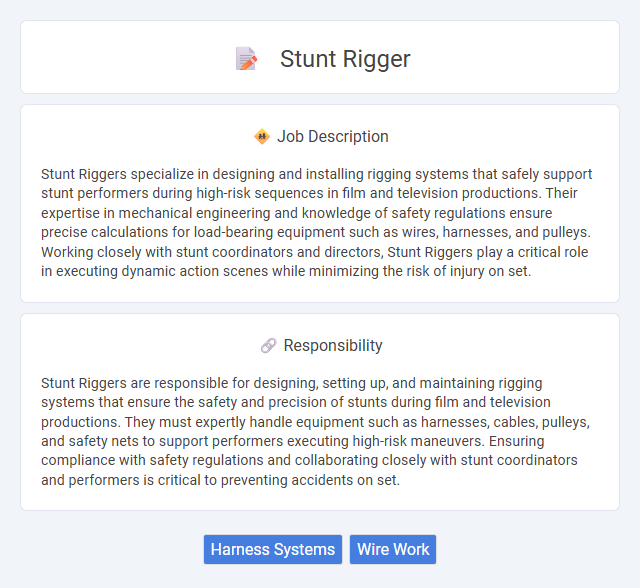
Stunt Riggers specialize in designing and installing rigging systems that safely support stunt performers during high-risk sequences in film and television productions. Their expertise in mechanical engineering and knowledge of safety regulations ensure precise calculations for load-bearing equipment such as wires, harnesses, and pulleys. Working closely with stunt coordinators and directors, Stunt Riggers play a critical role in executing dynamic action scenes while minimizing the risk of injury on set.
Individuals with strong physical fitness, excellent coordination, and a high tolerance for risk are likely to be well-suited for a stunt rigger role. Those who possess technical skills, attention to detail, and the ability to work calmly under pressure may find this job aligns with their capabilities. Conversely, people with health issues, fear of heights, or an aversion to dynamic work environments might be less suitable for this career path.
Qualification
A Stunt Rigger must have extensive knowledge of rigging equipment, safety protocols, and mechanical systems to ensure secure and precise setups for stunt sequences. Certification in rigging or climbing, combined with hands-on experience in the film or entertainment industry, is essential for managing complex aerial stunts and fall protections. Strong physical fitness and the ability to interpret technical drawings and safety regulations significantly enhance job performance and risk mitigation.
Responsibility
Stunt Riggers are responsible for designing, setting up, and maintaining rigging systems that ensure the safety and precision of stunts during film and television productions. They must expertly handle equipment such as harnesses, cables, pulleys, and safety nets to support performers executing high-risk maneuvers. Ensuring compliance with safety regulations and collaborating closely with stunt coordinators and performers is critical to preventing accidents on set.
Benefit
Stunt riggers likely enhance safety on film sets by expertly managing harnesses and rigging equipment, reducing the risk of accidents during complex stunts. Their expertise probably contributes to smoother stunt execution, which can save production time and costs. Working as a stunt rigger may also offer opportunities for career growth and collaboration within the entertainment industry.
Challenge
Stunt Rigger roles probably present significant challenges due to the high-risk environment and the necessity for precise safety measures. Navigating complex rigging setups likely requires both technical expertise and quick problem-solving abilities under pressure. The responsibility for performers' safety suggests that attention to detail and risk assessment skills are critically important in this job.
Career Advancement
Stunt Riggers play a crucial role in the film and television industry by designing and setting up safe rigging systems for stunt performers, which requires expertise in physics and safety protocols. Career advancement opportunities include progressing to Lead Rigger, Stunt Coordinator, or even Safety Supervisor roles, often demanding increased technical skills, leadership abilities, and industry certifications. Gaining experience on high-profile productions and networking within the stunt community significantly enhances prospects for promotion and specialization in complex stunt setups.
Key Terms
Harness Systems
Stunt riggers specializing in harness systems are responsible for designing, fitting, and maintaining safety harnesses that enable performers to execute complex aerial stunts and fight sequences securely. They ensure all harness components meet industry safety standards and meticulously inspect equipment before each use to prevent accidents. Expertise in load distribution and quick-release mechanisms is essential to enhance stunt precision and performer comfort during high-risk scenes.
Wire Work
A Stunt Rigger specializing in wire work is responsible for setting up and operating complex rigging systems that enable performers to execute high-flying stunts safely. Mastery in selecting high-tensile cables, harnesses, and pulleys ensures precise control over actor movements while minimizing risk. Expertise in synchronization with stunt coordinators and adherence to safety protocols is crucial for seamless and safe stunt performances.
 kuljobs.com
kuljobs.com